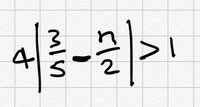Mathdabbler
New member
- Joined
- Sep 10, 2019
- Messages
- 11
I’ve tried to solve this inequality [the correct answer is given as (-1)] but it seems I am not treating the 4 in the equation correctly. Do I assume the 4 is multiplied by the part equation in the absolute brackets? Or is it multiplied by the 3/5 term only?
Any help to point me in the right direction will be appreciated
Any help to point me in the right direction will be appreciated

